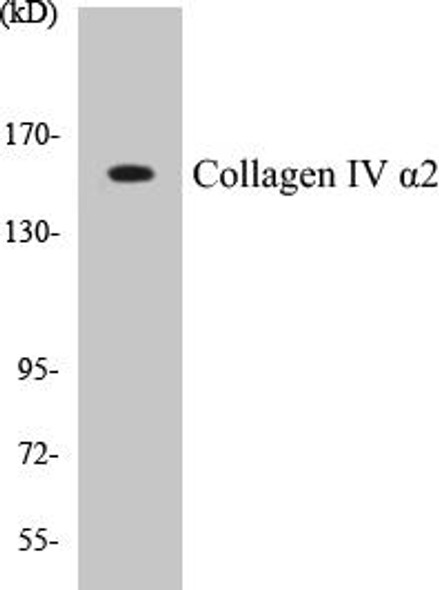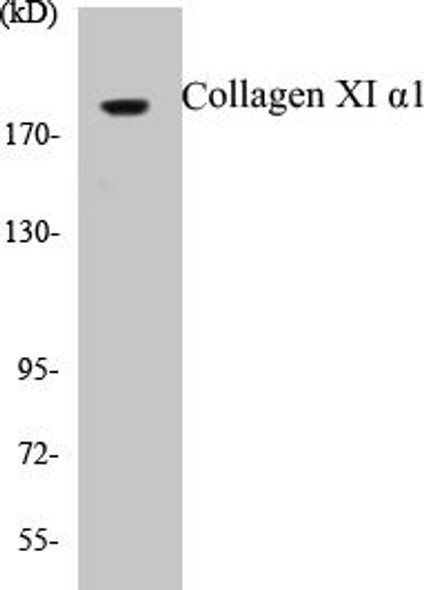Description
Collagen VI alpha2 Colorimetric Cell-Based ELISA Kit
The Collagen VI Alpha2 Colorimetric Cell-Based ELISA Kit is specifically designed for the accurate detection of Collagen VI Alpha2 levels in cell culture supernatants. This kit offers high sensitivity and specificity, ensuring reliable and reproducible results for a variety of research applications.Collagen VI Alpha2 is a key component of the extracellular matrix, playing a crucial role in tissue development and maintenance. Dysregulation of Collagen VI Alpha2 has been linked to various diseases and conditions, making it a valuable biomarker for studying these pathologies and developing potential treatments.
With its user-friendly protocol and high-performance features, the Collagen VI Alpha2 Colorimetric Cell-Based ELISA Kit is an essential tool for researchers looking to investigate the role of Collagen VI Alpha2 in physiological and pathological processes.
| Product Name: | Collagen VI alpha2 Colorimetric Cell-Based ELISA |
| Product Code: | CBCAB00594 |
| ELISA Type: | Cell-Based |
| Target: | Collagen VI alpha2 |
| Reactivity: | Human, Mouse |
| Dynamic Range: | > 5000 Cells |
| Detection Method: | Colorimetric 450 nmStorage/Stability:4°C/6 Months |
| Format: | 96-Well Microplate |
The Collagen VI alpha2 Colorimetric Cell-Based ELISA Kit is a convenient, lysate-free, high throughput and sensitive assay kit that can detect Collagen VI alpha2 protein expression profile in cells. The kit can be used for measuring the relative amounts of Collagen VI alpha2 in cultured cells as well as screening for the effects that various treatments, inhibitors (ie siRNA or chemicals), or activators have on Collagen VI alpha2.
Qualitative determination of Collagen VI alpha2 concentration is achieved by an indirect ELISA format. In essence, Collagen VI alpha2 is captured by Collagen VI alpha2-specific primary antibodies while the HRP-conjugated secondary antibodies bind the Fc region of the primary antibody. Through this binding, the HRP enzyme conjugated to the secondary antibody can catalyze a colorimetric reaction upon substrate addition. Due to the qualitative nature of the Cell-Based ELISA, multiple normalization methods are needed:
| 1. | A monoclonal antibody specific for human GAPDH is included to serve as an internal positive control in normalizing the target absorbance values. |
| 2. | Following the colorimetric measurement of HRP activity via substrate addition, the Crystal Violet whole-cell staining method may be used to determine cell density. After staining, the results can be analysed by normalizing the absorbance values to cell amounts, by which the plating difference can be adjusted. |
| Database Information: | Gene ID: 1292, UniProt ID: P12110, OMIM: 120240, Unigene: Hs.420269/Hs.625041 |
| Gene Symbol: | COL6A2 |
| Sub Type: | None |
| UniProt Protein Function: | COL6A2: Collagen VI acts as a cell-binding protein. Defects in COL6A2 are a cause of Bethlem myopathy (BM). BM is a rare autosomal dominant proximal myopathy characterized by early childhood onset (complete penetrance by the age of 5) and joint contractures most frequently affecting the elbows and ankles. Defects in COL6A2 are a cause of Ullrich congenital muscular dystrophy (UCMD); also known as Ullrich scleroatonic muscular dystrophy. UCMD is an autosomal recessive congenital myopathy characterized by muscle weakness and multiple joint contractures, generally noted at birth or early infancy. The clinical course is more severe than in Bethlem myopathy. Defects in COL6A2 are the cause of myosclerosis autosomal recessive (MYOSAR); also known as myosclerotic myopathy or congenital myosclerosis of Lowenthal. A condition characterized by chronic inflammation of skeletal muscle with hyperplasia of the interstitial connective tissue. The clinical picture includes slender muscles with firm 'woody' consistency and restriction of movement of many joints because of muscle contractures. Belongs to the type VI collagen family. 3 isoforms of the human protein are produced by alternative splicing. |
| UniProt Protein Details: | Protein type:Secreted, signal peptide; Secreted; Extracellular matrix Chromosomal Location of Human Ortholog: 21q22.3 Cellular Component: extracellular matrix; proteinaceous extracellular matrix; extracellular space; collagen; protein complex; endoplasmic reticulum lumen; extracellular region; vesicle; sarcolemma Molecular Function:protein binding Biological Process: axon guidance; collagen catabolic process; extracellular matrix disassembly; extracellular matrix organization and biogenesis; response to glucose stimulus; cell adhesion Disease: Bethlem Myopathy; Myosclerosis, Autosomal Recessive; Ullrich Congenital Muscular Dystrophy |
| NCBI Summary: | This gene encodes one of the three alpha chains of type VI collagen, a beaded filament collagen found in most connective tissues. The product of this gene contains several domains similar to von Willebrand Factor type A domains. These domains have been shown to bind extracellular matrix proteins, an interaction that explains the importance of this collagen in organizing matrix components. Mutations in this gene are associated with Bethlem myopathy and Ullrich scleroatonic muscular dystrophy. Three transcript variants have been identified for this gene. [provided by RefSeq, Jul 2008] |
| UniProt Code: | P12110 |
| NCBI GenInfo Identifier: | 125987812 |
| NCBI Gene ID: | 1292 |
| NCBI Accession: | P12110.4 |
| UniProt Secondary Accession: | P12110,Q13909, Q13910, Q13911, Q14048, Q14049, Q16259 Q16597, Q6P0Q1, Q9UML3, Q9Y4S8, |
| UniProt Related Accession: | P12110 |
| Molecular Weight: | 1019 |
| NCBI Full Name: | Collagen alpha-2(VI) chain |
| NCBI Synonym Full Names: | collagen, type VI, alpha 2 |
| NCBI Official Symbol: | COL6A2 |
| NCBI Official Synonym Symbols: | PP3610 |
| NCBI Protein Information: | collagen alpha-2(VI) chain; collagen alpha-2(VI) chain; collagen VI, alpha-2 polypeptide; human mRNA for collagen VI alpha-2 C-terminal globular domain |
| UniProt Protein Name: | Collagen alpha-2(VI) chain |
| Protein Family: | Collagen |
| UniProt Gene Name: | COL6A2 |
| UniProt Entry Name: | CO6A2_HUMAN |
| Component | Quantity |
| 96-Well Cell Culture Clear-Bottom Microplate | 2 plates |
| 10X TBS | 24 mL |
| Quenching Buffer | 24 mL |
| Blocking Buffer | 50 mL |
| 15X Wash Buffer | 50 mL |
| Primary Antibody Diluent | 12 mL |
| 100x Anti-Phospho Target Antibody | 60 µL |
| 100x Anti-Target Antibody | 60 µL |
| Anti-GAPDH Antibody | 60 µL |
| HRP-Conjugated Anti-Rabbit IgG Antibody | 12 mL |
| HRP-Conjugated Anti-Mouse IgG Antibody | 12 mL |
| SDS Solution | 12 mL |
| Stop Solution | 24 mL |
| Ready-to-Use Substrate | 12 mL |
| Crystal Violet Solution | 12 mL |
| Adhesive Plate Seals | 2 seals |
The following materials and/or equipment are NOT provided in this kit but are necessary to successfully conduct the experiment:
- Microplate reader able to measure absorbance at 450 nm and/or 595 nm for Crystal Violet Cell Staining (Optional)
- Micropipettes with capability of measuring volumes ranging from 1 µL to 1 ml
- 37% formaldehyde (Sigma Cat# F-8775) or formaldehyde from other sources
- Squirt bottle, manifold dispenser, multichannel pipette reservoir or automated microplate washer
- Graph paper or computer software capable of generating or displaying logarithmic functions
- Absorbent papers or vacuum aspirator
- Test tubes or microfuge tubes capable of storing ≥1 ml
- Poly-L-Lysine (Sigma Cat# P4832 for suspension cells)
- Orbital shaker (optional)
- Deionized or sterile water
*Note: Protocols are specific to each batch/lot. For the correct instructions please follow the protocol included in your kit.
| Step | Procedure |
| 1. | Seed 200 µL of 20,000 adherent cells in culture medium in each well of a 96-well plate. The plates included in the kit are sterile and treated for cell culture. For suspension cells and loosely attached cells, coat the plates with 100 µL of 10 µg/ml Poly-L-Lysine (not included) to each well of a 96-well plate for 30 minutes at 37°C prior to adding cells. |
| 2. | Incubate the cells for overnight at 37°C, 5% CO2. |
| 3. | Treat the cells as desired. |
| 4. | Remove the cell culture medium and rinse with 200 µL of 1x TBS, twice. |
| 5. | Fix the cells by incubating with 100 µL of Fixing Solution for 20 minutes at room temperature. The 4% formaldehyde is used for adherent cells and 8% formaldehyde is used for suspension cells and loosely attached cells. |
| 6. | Remove the Fixing Solution and wash the plate 3 times with 200 µL 1x Wash Buffer for five minutes each time with gentle shaking on the orbital shaker. The plate can be stored at 4°C for a week. |
| 7. | Add 100 µL of Quenching Buffer and incubate for 20 minutes at room temperature. |
| 8. | Wash the plate 3 times with 1x Wash Buffer for 5 minutes each time. |
| 9. | Add 200 µL of Blocking Buffer and incubate for 1 hour at room temperature. |
| 10. | Wash 3 times with 200 µL of 1x Wash Buffer for 5 minutes each time. |
| 11. | Add 50 µL of 1x primary antibodies (Anti-Collagen VI alpha2 Antibody and/or Anti-GAPDH Antibody) to the corresponding wells, cover with Parafilm and incubate for 16 hours (overnight) at 4°C. If the target expression is known to be high, incubate for 2 hours at room temperature. |
| 12. | Wash 3 times with 200 µL of 1x Wash Buffer for 5 minutes each time. |
| 13. | Add 50 µL of 1x secondary antibodies (HRP-Conjugated AntiRabbit IgG Antibody or HRP-Conjugated Anti-Mouse IgG Antibody) to corresponding wells and incubate for 1.5 hours at room temperature. |
| 14. | Wash 3 times with 200 µL of 1x Wash Buffer for 5 minutes each time. |
| 15. | Add 50 µL of Ready-to-Use Substrate to each well and incubate for 30 minutes at room temperature in the dark. |
| 16. | Add 50 µL of Stop Solution to each well and read OD at 450 nm immediately using the microplate reader. |
(Additional Crystal Violet staining may be performed if desired – details of this may be found in the kit technical manual.)






